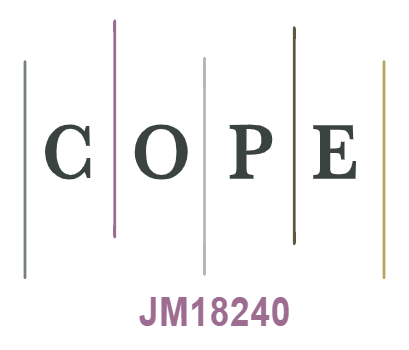مؤشرات تصلب الشرايين لدى المرضى العراقيين المصابين بالسكري من النوع الثاني وعلاقتها بمخاطر أمراض القلب والأوعية الدموية
DOI:
https://doi.org/10.32007/jfacmedbagdad.2075الكلمات المفتاحية:
مرض السكري، مرض السكري من النوع الثاني، أمراض القلب والأوعية الدموية، نسب الدهون، مؤشر تصلب الشرايين في البلازما.الملخص
خلفية البحث: مرض السكري هو عامل خطر لأمراض القلب والأوعية الدموية وتصلب الشرايين وسبب مهم للوفاة. يرتبط خلل الدهون في الدم بشكل شائع بمرض السكري من النوع الثاني ويعتبر مؤشر تصلب الشرايين في البلازما علامة قوية للتنبؤ بخطر الإصابة بتصلب الشرايين وأمراض القلب التاجية.
الهدف من البحث: دراسة ارتباط المؤشرات الدهنية لتصلب الشرايين لدى المرضى العراقيين المصابين بالسكري من النوع الثاني ولديهم أمراض قلبية وعائية.
المرضى وطرق العمل: أجريت هذه الدراسة السريرية في مستشفى بغداد التعليمي/ مدينة الطب - بغداد في الفترة من تشرين الأول 2022 ولغاية شباط 2023. تم مشاركة 60 مريضًا مصاباً بالسكري من النوع الثاني في هذه الدراسة. ثلاثون مريضا منهم كانوا يعانون من أمراض القلب والأوعية الدموية و 30 غير مصابين بأمراض القلب والأوعية الدموية. تراوحت أعمارهم بين 40-55 سنة. تم اختيار 30 فردًا سليما كمجموعة سيطرة.
النتائج: كان هناك ارتفاع كبير في فحوصات نسبة السكر والدهون في الدم لدى مرضى السكري المصابين بأمراض القلب والأوعية الدموية مقارنة مع أولئك الذين لا يعانون من أمراض القلب والأوعية الدموية ومجموعة السيطرة. أظهرت النتائج الحالية مستويات مرتفعة من نسب الدهون لدى مرضى السكري المصابين بأمراض القلب والأوعية الدموية. كشفت النتائج أيضًا عن مستويات عالية من البروتين الدهني غير عالي الكثافة لدى مرضى السكري المصابين بأمراض القلب والأوعية الدموية (241.8 ± 12.24 ملغم/ ديسيلتر) مقابل (150.1 ± 7.12 و 68.9 ± 5.1 ملغم/ ديسيلتر) لأولئك الذين لا يعانون من أمراض القلب والأوعية الدموية ومجموعة السيطرة على التوالي. كان مؤشر تصلب الشرايين للبلازما لدى مرضى السكري المصابين بأمراض القلب والأوعية الدموية مقارنة بمجاميع مرضى السكري والأصحاء (0.8 ± 0.09) مقابل (0.7 ± 0.03 و 0.2 ± 0.08) على التوالي. كان هناك ارتباط معنوي موجب بين مؤشر تصلب الشرايين للبلازما والعوامل الجسمية، صورة السكر والدهون في الدم مع نسبها لدى مرضى السكري مع وبدون أمراض القلب والأوعية الدموية.
الاستنتاجات: تؤكد نتائج هذه الدراسة أن مؤشرات الدهون هي مؤشرات خطر لضبط نسبة السكر في الدم بقيمة تنبؤية أعلى من العوامل التقليدية. أيضًا، ممكن اعتبار البروتين الدهني غير عالي الكثافة ومؤشر تصلب الشرايين في البلازما من العوامل الهامة للسيطرة على نسبة السكر في الدم.
التنزيلات
المراجع
- He X, Ou C, Xiao Y, Han Q, Li H, and Zhou S . LncRNAs: key players and novel insights into diabetes mellitus. Oncotarget. 2017;8(41):71325-71341. https://doi.org/10.18632/oncotarget.19921
- Fei Y, Tsoi MF, and Cheung BMY. Cardiovascular outcomes in trials of new antidiabetic drug classes: a network meta-analysis. Diabetes Cardiovascular Disease, 2019;18(1):1-13. https://doi.org/10.1186/s12933-019-0916-z
- Benjamin EJ, Blaha MJ, Chiuve SE, Cushman M, Das SR, Deo R, et al. Heart disease and stroke statistics-2017 update: a report from the American Heart Association. Circulation. 2017;135(10):e146-603. https://doi.org/10.1161/CIR.0000000000000491
- Pang M, Li Y, Gu W, Sun Z, Wang Z, and Li L. Recent advances in epigenetics of macrovascular complications in diabetes mellitus. Heart, Lung and Circulation, 2021; 30(2):186-196. https://doi.org/10.1016/j.hlc.2020.07.015
- Zhu Z, Li J, Tong R, Zhang X, and Yu B. miR-149 alleviates ox-LDL-induced endothelial cell injury by promoting autophagy through Akt/mTOR pathway. Cardiol Res Pract. 2021;2021:9963258. https://doi.org/10.1155/2021/9963258
- Florido R, Zhao D, Ndumele EN, Lutsey PL, McEvoy JW, Windham BG, et al. Physical activity, parental history of premature coronary heart disease, and incident atherosclerotic cardiovascular disease in the atherosclerosis risk in communities (ARIC) study. J Am Heart Assoc. 2016; 5(9):e003505. https://doi:10.1161/ JAHA. 116.003505. https://doi.org/10.1161/JAHA.116.003505
- National Cholesterol Education Program (NCEP) Expert Panel on Detection, Evaluation, and Treatment of High Blood Cholesterol in Adults (Adult Treatment Panel III). Third Report of the National Cholesterol Education Program (NCEP) Expert Panel on Detection, Evaluation, and Treatment of High Blood Cholesterol in Adults (Adult Treatment Panel III) final report. 2002;106(25):3143-3421.
https://doi.org/10.1161/circ.106.25.3143
- Dobiasova M and Frohlich J. The plasma parameter log (TG/HDLC) as an atherogenic index: correlation with lipoprotein particle size and esterification rate in apoB-lipoprotein-depleted plasma (FERHDL). Clin Biochem. 2001;34(7):583-588.
https://doi.org/10.1016/S0009-9120(01)00263-6
- Kavey REW, Daniels SR, Lauer RM, Atkins DL, Hayman LL, Taubert K; et al. American Heart Association guidelines for primary prevention of atherosclerotic cardiovascular disease beginning in childhood. Circulation, 2003; 107(11):1562-1566.
https://doi.org/10.1161/01.CIR.0000061521.15730.6E
- Rajaei E, Jalali MT, Shahrabi S, Asnafi AA, and Pezeshki SMS. HLAs in autoimmune diseases: Dependable diagnostic biomarkers? Curr Rheumatol Rev., 2019;15(4):269-276. https://doi.org/10.2174/1573397115666190115143226
- Langlois MR and Sniderman AD. Non-HDL cholesterol or apo B: which to prefer as a target for the prevention of atherosclerotic cardiovascular disease? Curr Cardiol Rep. 2020;22(8):67. https://doi.org/10.1007/s11886-020-01323-z
- Einarson TR, Acs A, Ludwig C, and Panton UH. Prevalence of cardiovascular disease in type 2 diabetes: a systematic literature review of scientific evidence from across the world in 2007-2017 Cardiovasc Diabetol., 2018; 17(83):1-19.
https://doi.org/10.1186/s12933-018-0728-6
- Al-Salameh A, Chanson P, Bucher S, Ringa V, and Becquemont L. Cardiovascular disease in type 2 diabetes: a review of sex-related differences in predisposition and prevention, Mayo Clinic Proceedings, 2019;94(2):287-308.
https://doi.org/10.1016/j.mayocp.2018.08.007
- Tahir NT, Ahmed HS, and Gaiz AA. Leptin and insulin resistance in obese children. Al-Kindy College Medical Journal. 2014;10(2):36-40. https://jkmc. uobaghdad.edu. iq/index.php/MEDICAL/article/view/449.
- Emerging Risk Factors Collaboration, Wormser D, Kaptoge S, Angelantonio ED, Wood AM, Pennells L, et al. Separate and combined associations of body-mass index and abdominal adiposity with cardiovascular disease: collaborative analysis of 58 prospective studies. Lancet. 2011;377(9771):1085-1095. https://doi.org/10.1016/S0140-6736(11)60105-0
- Obeed AA, AL-Kinani TA, and AL-Qadhi HI. Effect of Dapagliflozin on hemoglobin level in heart failure patients with chronic kidney disease and/or diabetes. J Fac Med Baghdad, 2022;64(4):203-207. https://doi.org/10.32007/jfacmedbagdad
- Doostvandi T, Bahadoran Z, Mozaffari-Khosravi H, Tahmasebinejad Z, Mirmiran P, and Azizi F. The association of dietary patterns and the incidence of insulin resistance after a 3-year follow-up: Tehran lipid and glucose study. Asia Pac J Clin Nutr 2017;26(3):531-538. https://doi:10.6133/apjcn.032016.12.
- Onyango AN. Excessive gluconeogenesis causes the hepatic insulin resistance paradox and its sequelae. Heliyon, 2022;8 (e12294):1-13. https://doi.org/10.1016/j.heliyon.2022.e12294
- Tahir NT, Ahmed HS, and Mahmmod OK. Correlation between high sensitivity C reactive protein and incident type 2 diabetes among newly diagnosed renal impairment patients. Iraqi Journal of Community Medicine, 2020;33(1):10-14.
https://doi.org/10.4103/IRJCM.IRJCM_7_20
- Abdulrahman ZS, Alatrakji MQ, Al-Maliky AA, Hussein KI, and Hussain SA. Influence of metformin dose and treatment adherence on glycemic control, adiposity, and cardiovascular risk markers in Iraqi patients with T2DM. J Fac Med Baghdad. 2022;64(4):218-226.
https://doi.org/10.32007/jfacmedbagdad.6441939
- Ahmed HS. Serum adropin and apelin as potential markers predicting acute heart failure-associated renal dysfunction among elderly Iraqi patients. Ann Trop Med & Public Health, 2020;23(S10):SP231024. https://doi.org/10.36295/ASRO.2020.231024
- Raoof EM and Ahmed HS. Circulating adipsin as biomarker and its implication in type 2 diabetes mellitus. IJDDT, 2022;12(2):588-593. http://impactfactor.org/ PDF/ IJDDT/12/IJDDT,Vol12,Issue2,Article21.pdf.
- Ahmed HS. Correlations between serum interleukins-2,-4 levels and some biochemical parameters in Iraqi patients with osteoporosis. Fac Med Baghdad 2017; 59(3):275-279. https://doi.org/10.32007/jfacmedbagdad.593103
- Ahmed HS. Obesity and breast cancer: Circulating adipokines and their potential diagnostic as risk biomarkers. Int. J. Res. Pharm. Sci. 2020:11(3):3061-3068. https://doi.org/10.26452/ijrps.v11i3.2408
- Ahmed HS. Apolipoprotein B as a biomarker in patients with stable and unstable angina pectoris. International Journal for Sciences and Technology. 2013;8(2):36-40. https://doi.org/10.12816/0010050
- Ahmed HS. Assessment of apolipoproteins A1, E, and insulin resistance in Iraqi male patients with acute myocardial infarction. Iraqi Journal of Community Medicine, 2020;33(2):71-76. https://doi.org/10.4103/IRJCM.IRJCM_4_21
- Yeh WC, Tsao Y-C, Li WC, Tzeng IS, Chen LS, and Chen JY. Elevated triglyceride-to-HDL cholesterol ratio is an indicator for insulin resistance in middle-aged and elderly Taiwanese population: a cross-sectional study. Lipids in Health and Disease, 2019;18(176):1-7.
https://doi.org/10.1186/s12944-019-1123-3
- Kunutsor KS, Zaccardi F, Karppi J, Kurl S, and Laukkanen JA. Is high serum LDL/HDL-cholesterol ratio an emerging risk factor for sudden cardiac death? Findings from the KIHD study. J Atheroseler Thromb. 2017;24(6):600-608.
https://doi.org/10.5551/jat.37184
- McGrowder DA. Biochemical parameters as cardiovascular risk factors in obese children and adults. J Endocrinol Diabetes Obes. 2018;6(1):1115. https://www. jscimedcentral.com/public/assets/articles/endocrinology-6-1115.pdf.
- Tahir NT, Ahmed HS, and Mohsen FY. Vitamin D and risk of osteoarthritis among Iraqi patients with and without metabolic syndrome. Plant Archives. 2020; 20(1): 2731-2736. http://www.plantarchives.org/20-1/2731-2736%20(6180).pdf.
- Cai G, Ganwei S, Xue S, and Lu W. The atherogenic index of plasma is a strong and independent predictor for coronary artery disease in the Chinese Han population. Medicine. 2017;96(37):e8058. https://doi.org/10.1097/MD.0000000000008058
- Panjeta E, Jadric R, Panjeta M, Coric J, and Dervisevic A. Correlation of serum lipid profile and glycemic control parameters in patients with type 2 diabetes mellitus. J Health Sci 2018;8(2):110-116. https://doi.org/10.17532/jhsci.2018.488
- Feng C, Wang H, Lu N, and Tu XM. Log transformation: application and interpretation in biomedical research. Stat Med. 2013;32(2):230-239. https://doi.org/10.1002/sim.5486
- Wu TT, Gao Y, Zheng YY, Ma YT, and Xie X. Atherogenic index of plasma (AIP): a novel predictive indicator for the coronary artery disease in postmenopausal women. Lipids Health Dis. 2018;17(1):197. https://doi.org/10.1186/s12944-018-0828-z
- Liu T, Liu J, Wu Z, Lv Y, and Li W. Predictive value of the atherogenic index of plasma for chronic total occlusion before coronary angiography. Clin Cardiol. 2021; 44(4):518-525. https://doi.org/10.1002/clc.23565
- Won KB, Heo R, Park HB, Lee BK, Lin FY, Hadamitzky M, et al. Atherogenic index of plasma and the risk of rapid progression of coronary atherosclerosis beyond traditional risk factors. Atherosclerosis.2021;324:46-51. https://doi:10.1016/j. atherosclerosis. 2021.03.009.
- Turki KM, Ahmed HS, and Saifullah PH. LDL particles size index and lipid peroxidation in type 2 diabetic male patients. Iraqi Postgraduate Medical Journal.2013;12(1):57-61. https://www.iasj.net/iasj/article/70986 .
- Santos HO, Earnest CP, Tinsley GM, Izidoro LFM, and Macedo RCO. Small dense low-density lipoprotein-cholesterol (sdLDL-C): analysis, effects on cardiovascular endpoints and dietary strategies. Prog Cardiovasc Dis. 2020;63(4): 503-509.
https://doi.org/10.3389/fcvm.2021.804214
- Ikezaki H, Furusyo N, Yokota Y, Ai M, Asztalos BF, Murata M, et al . Small dense low-density lipoprotein cholesterol and carotid intimal medial thickness progression. J Atheroscler Thromb. 2020;27(10):1108-1122. https://doi.org/10.5551/jat.54130
- Liou L and Kaptoge S. Association of small, dense LDL-cholesterol concentration and lipoprotein particle characteristics with coronary heart disease: a systematic review and meta-analysis. PLOS ONE. 2020;15(11):e0241993.
https://doi.org/10.1371/journal.pone.0241993
- Duan R, Xue W, Wang K, Yin N, Hao H, Chu H, et al. Estimation of the LDL subclasses in ischemic stroke as a risk factor in a Chinese population. BMC Neurol. 2020;20(414):1-9. https://doi.org/10.1186/s12883-020-01989-6
التنزيلات
منشور
إصدار
القسم
الرخصة
الحقوق الفكرية (c) 2023 Hind Shakir Ahmed,Melak Saleh Mohammed

هذا العمل مرخص بموجب Creative Commons Attribution 4.0 International License.










 Creative Commons Attribution 4.0 International license..
Creative Commons Attribution 4.0 International license..


